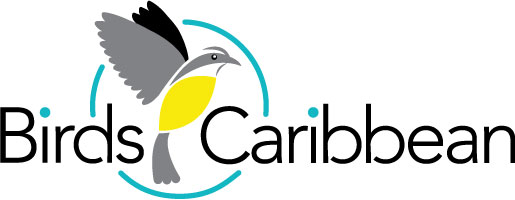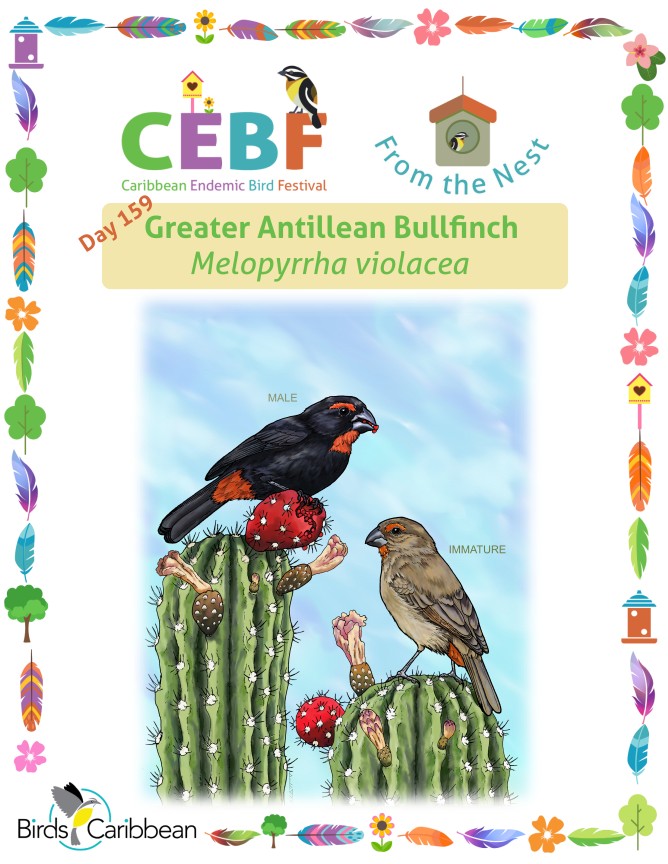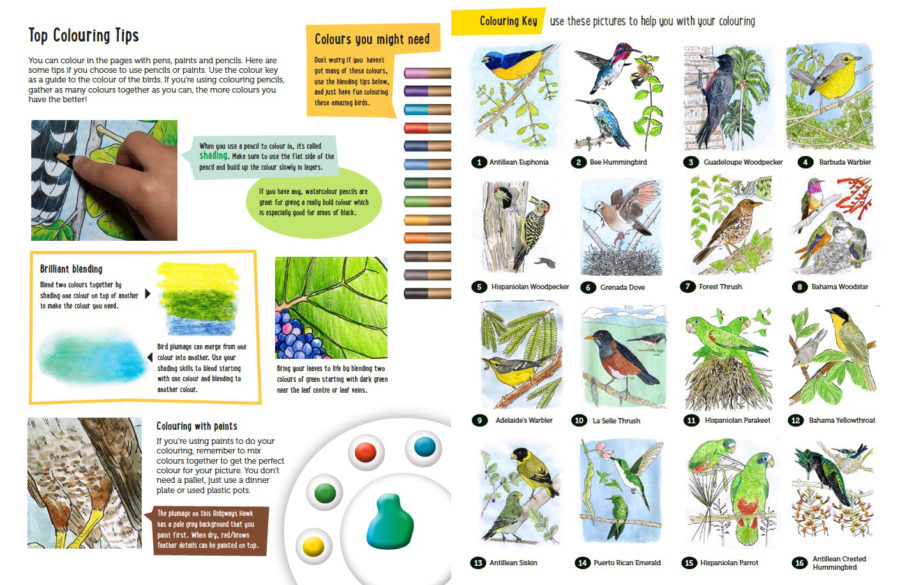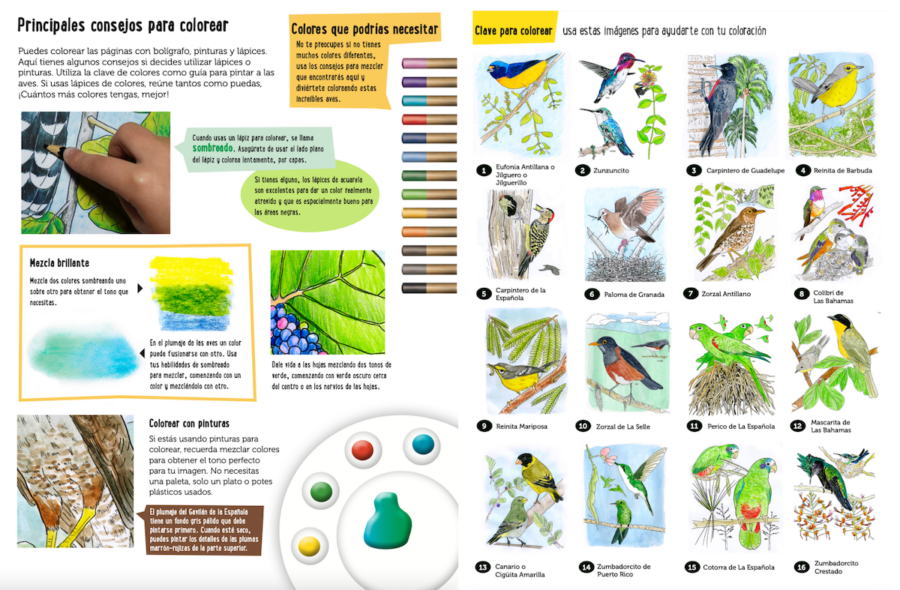Celebrate the Caribbean Endemic Bird Festival (CEBF) with us! Our theme in 2025 is “Shared Spaces: Creating Bird-friendly Cities and Communities”—highlighting the crucial role bird-friendly cities and communities can have in addressing the decline in bird populations caused by threats like habitat loss, predation, and climate change. Have fun learning about a new endemic bird every day. We have colouring pages, puzzles, activities, and more. Download for free and enjoy learning about and celebrating nature!
Endemic Bird of the Day: Greater Antillean Bullfinch
Small but striking, the Greater Antillean Bullfinch is endemic to the islands of The Bahamas, Turks and Caicos, Hispaniola, and Jamaica. Measuring around 14 cm in length, and weighing just 18-22 grams—about the same as five sugar packets—this lively songbird is easy to spot if you know what to look for.
Males are glossy black, accessorized with bold reddish-orange eyebrow stripe, throat and undertail-coverts (feathers under the tail). Their shrill, whistle-like “t’zeet, t’zeet, t’seet, t’seet, seet, seet, seet” calls have earned them the endearing nickname ‘police bird’ in The Bahamas. Females look similar to males but are a duller black with more muted red markings. Juveniles are grayish-olive and have similar but smaller reddish-orange markings, especially on the throat,
This bullfinch’s short, thick black beak is perfectly built for cracking open seeds from a wide variety of plants. But it’s not a picky eater—it also feeds on flower buds and petals, many different fruits, like green plantain, coffee and peppers, as well as insects and even snails! This versatile diet helps the Greater Antillean Bullfinch thrive in many habitats, from dry coastal shrublands and gardens to lush mountain forests. You’re most likely to spot them foraging in the understory, either alone or in small, lively groups.
During courtship, males put on a show by puffing out their feathers and performing their signature little hop around the female. Once paired, the female builds a cozy bowl-shaped nest using strips of palm fronds and tree bark. She typically lays 3 to 4 bluish-white eggs marked with fine red-brown and yellow-brown speckles between March and June.
This captivating bird is currently listed as ‘Least Concern’ on the IUCN Red List, thanks to its wide range and adaptable nature. Although tree cover has declined in many areas across its range, its population remains stable. These hardy birds have shown a remarkable ability to adapt—even surviving in degraded forests.
Still, this species faces increasing challenges. Habitat loss from development and the growing impacts of climate change pose real threats to their survival. Protecting the Greater Antillean Bullfinch means taking action now—planting native trees where they live—including your backyard, switching to organic pesticides that won’t harm the insects they feed on, and supporting efforts to conserve forests and restore habitats across the region. Learn more about this species, including its range, photos, and calls here. Great news! If you’re in the Caribbean, thanks to BirdsCaribbean, you have free access to Birds of the World and you can find out even more in the full species account of this bird!
Thanks to Arnaldo Toledo for the illustration and Soraya Halkitis for the text!
Colour in the Greater Antillean Bullfinch
Download our West Indies Endemic Bird colouring page. Use the photos below as your guide, or you can look up pictures of the bird online or in a bird field guide if you have one. Share your coloured-in page with us by posting it online and tagging us @BirdsCaribbean #CEBFfromthenest
Listen to the song of the Greater Antillean Bullfinch
The song of the Greater Antillean Bullfinch is a series of high-pitched “zit” or “seet” notes, sometimes followed by high thin buzz.
Puzzle of the Day
Click on the image below to do the puzzle. You can make the puzzle as easy or as hard as you like – for example, 6, 8, or 12 pieces for young children, all the way up to 1,024 pieces for those that are up for a challenge!

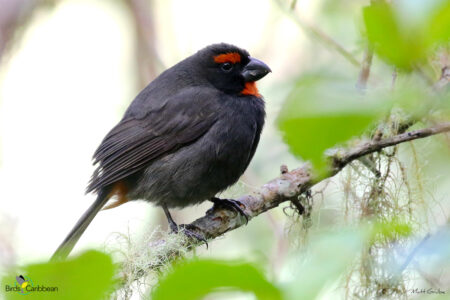
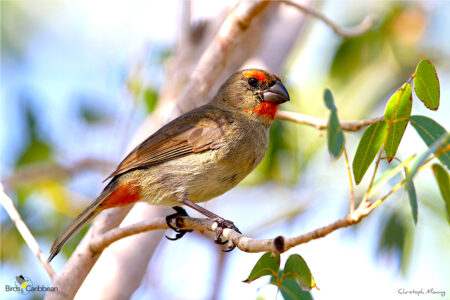
Activity of the Day
FOR KIDS : During our 2025 celebration of Caribbean endemic birds we will be sharing a beautiful colouring page for every single bird we feature! These lovely pages were created for us by Arnaldo Toledo, who also created a coloured in version of each bird as inspiration. Get your colour pencils ready, and read these super helpful colouring in tips below. Then go ahead, download and print each bird, and get colouring! Enjoy!
Estos consejos también están disponibles en español:
FOR KIDS AND ADULTS : Enjoy this video of a Greater Antillean Bullfinch in the wild!
